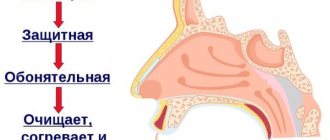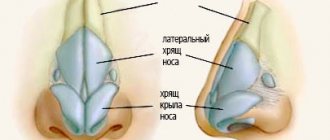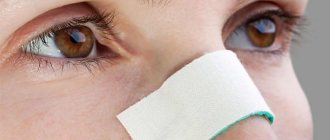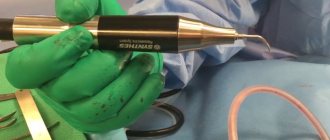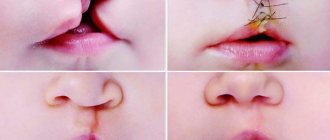The nasal septum is a wall of thin bone and cartilage in the nasal cavity that divides it in half.
When a deviated septum occurs, a person faces various breathing problems: swelling, difficulty breathing and respiratory failure, chronic rhinitis, sinusitis and others.
Doctors correct this deficiency using endoscopic and laser septoplasty methods.
The essence of the operation
Endoscopic septoplasty is a gentle operation that makes it possible to:
- Restore the correct position of the nasal septum;
- Remove excess tissue;
- Correct the bone or cartilage wall.
The procedure takes place in a hospital setting using special tools and equipment.
The patient is given a choice of general or local anesthesia, after which an operation is performed that lasts several hours.
The first day after surgery, the patient is in the hospital, and full recovery occurs after 7-10 days.
Septoplasty takes place almost without blood, using the endonasal method (through the nostrils), and does not leave scars on the face. The appearance of the nose also remains unchanged.
The price of endoscopic septoplasty ranges from 20,000 to 80,000 rubles - depending on the city, clinic and complexity of the operation.
Septoplasty methods
During surgery, the nasal septum is straightened and centered.
Previously, a deviated septum was removed completely, but this caused a lot of complications - for example, there were cases when a patient’s septum sagged after septoplasty, etc.
Some doctors still practice this method today, although this surgical technique is considered outdated.
Modern plastic surgeons strive to preserve the elements of the septum as much as possible as a support for the external nose.
Septoplasty is often performed simultaneously with rhinoplasty.
Indications for surgery
Endoscopic septoplasty of the nasal septum is prescribed according to medical indications, the basis for which is various disorders of the respiratory system:
- Acute sinusitis up to 4 times a year.
- Chronic sinusitis.
- Nosebleeds.
- Ronchopathy.
- Chronic inflammation of the mucous membrane.
- Manifestations of allergies.
- Feeling of dryness in the nasal cavity.
- Sinusitis, frontal sinusitis.
- Constant nasal congestion regardless of the time of year.
- Heavy, noisy breathing.
Optimal age for septoplasty : no earlier than 18 and no later than 40 years.
The growth of cartilage tissue continues up to 24 years , so surgery before the formation of the osteochondral system is completed can cause aggravation of the situation.
Endoscopic septoplasty at an early age can provoke further deformation, the correction of which will require re-plasty.
Contraindications
Contraindications include:
- Disorders of coagulation, or blood clotting.
- Severe cardiovascular diseases.
- Age up to 18 years.
- Oncological diseases.
- Viral, infectious diseases.
- Diabetes.
- Pathology of internal organs.
What's happened
Endoscopic septoplasty is a gentle procedure to correct nasal septum defects. Moreover, if we compare this technique with similar manipulations, its advantage lies in its low cost.
The operation is performed using an endoscope. Thanks to such an instrument, the surgeon can control all the actions he performs, in particular, the movement of the cutting object and the formation of cartilage tissue.
The main feature of surgical intervention is that it is highly effective, does not take much time and does not require long-term rehabilitation.
This operation is prescribed when there is a pronounced increase in the nasal septum as a result of the growth of cartilage tissue, when the organ is deformed and nasal breathing is impaired.
Execution technique
The surgeon makes an incision inside the nose, which will subsequently not be visible and will not cause inconvenience to the patient. Deformed areas of bone and cartilage are removed from the cavity, but one should not assume that in their place holes will appear in the septum - it will only become a little thicker, and the mucous and fibrous tissue will remain in place.
If necessary, the specialist can simultaneously perform additional endonasal procedures.
Upon completion of the process, the surgeon will fill the nasal cavity with tampons, which must be removed 1-3 days after septoplasty.
The respiratory functions of the nose are not restored immediately, as it will take time for the swelling to disappear, the cavity to heal, and the crusts to be removed.
Improvement in breathing is usually noted after a few weeks.
Nose care after septoplasty
The first two days after the operation, the patient remains in the hospital under the supervision of a doctor. During this period, the patient cannot breathe through the nose, since special gauze swabs are installed in the nasal cavity to promote proper fusion of cartilage and bone and prevent the development and suppuration of a postoperative hematoma. True, today there are also modern tampons with a tube inside through which the patient can breathe, but these channels must be regularly cleaned of mucus and crusts. This is much more convenient, since it is extremely uncomfortable to breathe only through your mouth for several days. The patient is prescribed strict bed rest and a strict diet.
After discharge from the ENT hospital, care after septoplasty for the nasal cavity, or rather, its control and responsibility, falls on the shoulders of the patient himself. The ENT surgeon, for his part, must alert the patient to the importance and seriousness of the postoperative period. The patient needs:
- conduct follow-up visits to your ENT surgeon once every two to three days to monitor the dynamics of the condition;
- be sure to promptly change the sterile cotton swabs placed in the nasal passages, which is especially important in the first postoperative days;
- two to three weeks after surgery, carry out mandatory nasal rinsing. Saline solutions are used to clean the nasal cavity (you can prepare them yourself, or it is better to buy ready-made ones from pharmacies). This cleansing of the nose helps relieve swelling and make breathing easier.
- cleaning the nasal passages from crusts is a consequence of dried blood clots. If they are not removed, breathing will become extremely difficult. For cleaning, you can use regular saline solution, which is instilled into the nasal passages, and cotton swabs, which are used to directly remove them. But this can only be done superficially. Deep cleansing is carried out only by an ENT doctor.
- The recovery period requires mandatory abandonment of bad habits:
- It is necessary to avoid high temperatures (exposure to the sun, baths, saunas, solariums), any physical activity, and temporarily stop wearing glasses.
| Medical service | price, rub. |
| Toilet of the nasal cavity after septoplasty | 1000 |
Photos before and after
Postoperative period
Immediately after endoscopic septoplasty, the patient is given a cold compress on the septum area, and antibiotics and painkillers are also prescribed.
During the first few days, it is mandatory to carry out hygienic procedures - rinsing the nose with saline or saline, lubricating with ointment or using drops/spray as recommended by a specialist.
For two to three weeks after surgery, it is not recommended to visit the pool, sauna, and heavy physical activity should be avoided.
Contraindications
Despite the popularity of this manipulation and good positive results, the technique has its certain limitations, among which are:
- bleeding disorders and other blood pathologies;
- liver failure , occurring in acute form;
- pathological processes of infectious or viral origin;
- HIV;
- oncological diseases;
- diabetes mellitus and other endocrine system disorders;
- tuberculosis;
- strokes and heart attacks;
- worsened chronic pathologies;
- old age of the patient.
In addition, surgery is contraindicated during pregnancy and breastfeeding.
Possible complications
Endoscopic septoplasty usually does not have complications, but they are possible - just like after any other surgical intervention.
Undesirable side effects may include:
- Bleeding,
- Hyperemia,
- pain,
- Swelling.
- Damage to the mucous membrane,
- Hematomas,
- Sinusitis,
- Nose modification
- Abscess,
- Infectious diseases.
To avoid negative consequences after endoscopic septoplasty, you should regularly pack the nasal passages, rinse the nasal cavity with saline and take antibacterial drugs.
Carrying out
In modern surgery, preference is given to minimally invasive interventions, which provide high effectiveness, rapid recovery and a low risk of complications. Therefore, septoplasty in most cases is performed endoscopically. Deformed tissues are removed as gently as possible by submucosal or conventional resection, all done without external incisions.
Laser septochondrocorrection is considered a separate technique. It allows you to correct crooked cartilage on the front of the nasal septum. Deformed parts are evaporated by laser radiation. The operation lasts no more than an hour. The type of anesthesia is determined individually (most often local). But with more pronounced changes in the external nose, rhinoplasty is required.
Reviews
Konstantin, 27 years old, Samara : “I decided to undergo endoscopic septoplasty because of a chronic runny nose: I took tests, was worried... but the operation went quickly and without any difficulties. I felt almost no pain. After the operation, I did not go to the pool for three weeks. But now I’m breathing deeply – thanks to the doctors!”
Olga, 38 years old, Yekaterinburg : “A friend talked me into having the operation - she said it would be quick and painless. It turned out not quite so. A day later I started bleeding and had to go to the clinic. They put a tampon on me and told me not to blow my nose. After 2 months, I’m happy with the result.”
Diana, 25 years old, Moscow : “I am tormented with my chronic nasal congestion. I went to an otolaryngologist and found out that this was due to a deviated septum. I decided to have surgery right away - the price was affordable, there were minimal complications. I was pleased with the result - I began to smell better and breathe easier! So I solved an old problem.”
Preparation
An operation to correct the nasal septum requires certain preparatory measures.
First of all, the patient should come to an appointment with the attending physician, who will examine the affected area, identify the severity of the problem and give a referral for a diagnostic examination.
A week before the expected date of correction, the patient must undergo a general urine and blood test, a blood test for sugar, coagulation, syphilis, hepatitis and HIV, group and Rh factor.
On this topic
- Septoplasty
Laser correction of nasal septum
- Editorial board of Plasticology.ru
- August 7, 2020
If surgery is prescribed for a woman, a pregnancy test must be done.
It is also necessary to do an electrocardiogram and fluorography.
If the examination results confirm the absence of contraindications and the presence of significant indications, the specialist will give recommendations on further preparation for surgery.
No later than 7 days in advance, you need to eliminate smoking and drinking alcohol from your life. Women will need to refrain from applying decorative cosmetics to their faces and performing any cosmetic procedures.
During the preparatory period, it is prohibited to eat food and take medications that have a negative effect on blood clotting. Citrus fruits, chocolate and other sweets should be excluded from the diet.
A light dinner is allowed the night before surgery. On the day of the procedure, you should not eat or drink, since it must be done on an empty stomach.
If the patient experiences psycho-emotional stress, a sedative can be taken.
